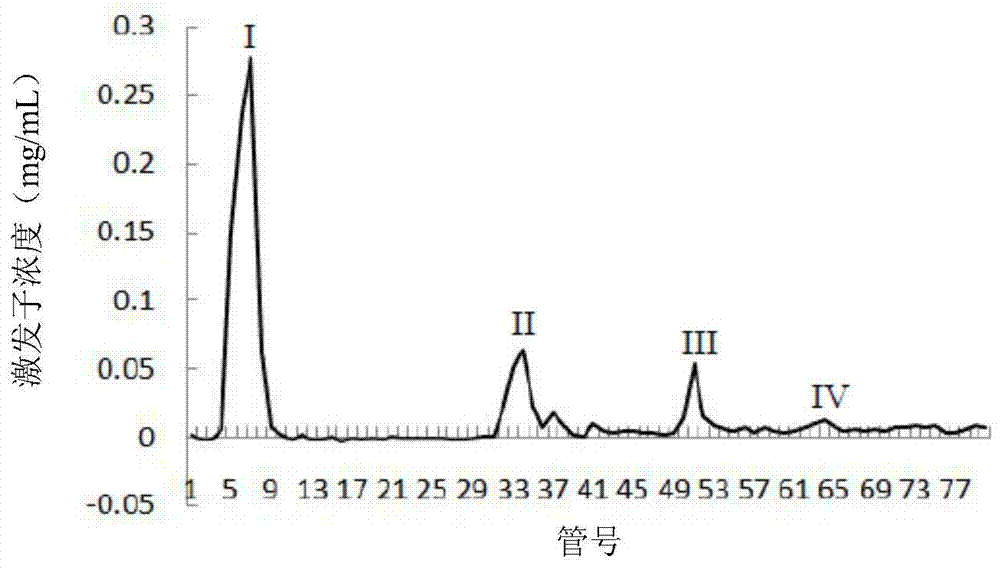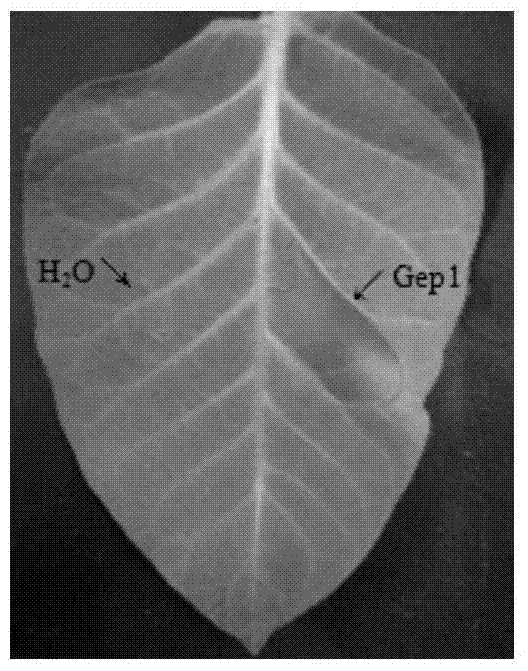A Phytophthora polysaccharide elicitor gep1 and its application in improving plant disease resistance
A technology of elicitors and polysaccharides, applied in the fields of application, plant growth regulators, plant growth regulators, etc., can solve the problems of isolated glucan elicitors, etc., and achieve the effect of alleviating symptoms and inhibiting proliferation
- Summary
- Abstract
- Description
- Claims
- Application Information
AI Technical Summary
Problems solved by technology
Method used
Image
Examples
Embodiment 1
[0053] A Phytophthora polysaccharide elicitor Gep1 is prepared by the following steps:
[0054] 1. Cultivation of Phytophthora tobacco (P.parasitica) fermentation broth and extraction of crude polysaccharides:
[0055] Inoculate the activated Phytophthora tabacum (P.parasitica) (China Agricultural Microorganism Culture Collection and Management Center, strain preservation number ACCC36285) mycelium block into (picking the mycelium block with a diameter of 1 cm at the edge of the colony) potato sucrose culture solution In 250mL (600g of potatoes, 20g of glucose, dilute to 1000mL with water, the final concentration of kanamycin is 50μg / mL), cultivate in the dark at 26°C and 200r / min for 24 days, and obtain the fermentation broth (the cell concentration is 1×10 7 CFU / mL).
[0056] The fermentation broth was first filtered with 4 layers of gauze, the filtrate was centrifuged at 3000r / min for 10min, and the supernatant was collected. The resulting supernatant was concentrated to ...
Embodiment 2
[0066] Monosaccharide composition analysis of polysaccharide elicitor Gep1:
[0067] Weigh 10 mg of the polysaccharide sample into an ampoule, add 2 mL of 2M trifluoroacetic acid solution, seal with an alcohol blowtorch, and hydrolyze at 120°C for 3.5 hours. After cooling, remove the insolubles by filter membrane filtration, remove trifluoroacetic acid by rotary evaporation under reduced pressure, wash with a small amount of methanol, continue rotary evaporation, repeat 3 times, remove residual trifluoroacetic acid, add 0.5mL distilled water to dissolve. Use a 20×20cm silica gel plate to separate, the developer is ethyl acetate-pyridine-absolute ethanol-water (volume ratio=8:1:1:2), and the color developer is aniline-diphenylamine-phosphoric acid (2% Aniline acetone solution, 2% aniline acetone solution, and 85% phosphoric acid are mixed in a ratio of 5:5:1). Take the standard solution (10mg / mL) of each monosaccharide (glucose, fructose, ribose, mannose, galactose, xylose, L-ar...
Embodiment 3
[0070] Detection of physicochemical properties of polysaccharide elicitor Gep1:
[0071] Thermal stability detection of polysaccharide elicitor Gep1: Take 100 μL of polysaccharide elicitor Gep1 (1 mg / mL), incubate in water baths at 40, 60, 70, 80, 90 and 100 °C for 5 min, and then quickly place them on ice, After cooling, centrifuge at 4°C and 12000r / min for 5min, and take the supernatant. After the solution returned to room temperature, its biological activity was tested according to the biological activity identification method described in Example 2. Distilled water was used as a control, and each treatment was repeated 3 times. In addition, 100 μL of polysaccharide elicitor (1 mg / mL) was taken, boiled water bath for 20, 30, 40, 50 and 60 min, and sterilized by high-pressure damp heat at 121 °C for 20 min, and its biological activity was detected by the same method as above.
[0072] The result is as Figure 5 As shown in middle A, a1-a6 in the figure are Gep1 after 20, ...
PUM
 Login to View More
Login to View More Abstract
Description
Claims
Application Information
 Login to View More
Login to View More - R&D
- Intellectual Property
- Life Sciences
- Materials
- Tech Scout
- Unparalleled Data Quality
- Higher Quality Content
- 60% Fewer Hallucinations
Browse by: Latest US Patents, China's latest patents, Technical Efficacy Thesaurus, Application Domain, Technology Topic, Popular Technical Reports.
© 2025 PatSnap. All rights reserved.Legal|Privacy policy|Modern Slavery Act Transparency Statement|Sitemap|About US| Contact US: help@patsnap.com



